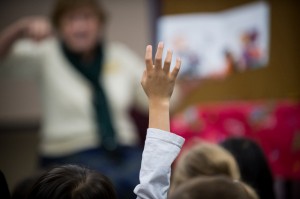
During my teaching career, I taught pre-K in high-poverty areas in the District of Columbia, but I also taught for a year in a high-income, suburban area in Maryland. There was a stark difference in students’ vocabulary and background knowledge. Most of my students from a low-income background didn’t have the breadth of vocabulary that some of my higher income students possessed.
Although this was my own personal experience, it is backed up by research which says that by the age of four, poor children in the United States hear 30 million fewer words than children from middle- to upper-income families. The importance of this statistic cannot be overstated. By the time children are in fourth grade, according to the National Assessment of Educational Progress, 80% of children from low-income households are not reading on grade-level.
Whether we call this the “word gap” (a phrase that rankles some experts) or use some other terminology (could it be replaced with a less-deficit-focused buzzword?), the need is the same: Children of all socio-economic levels need to experience language-rich conversations with caring adults to become not only literate, but also able to think critically about the world around them.
Over the past few years, a growing number of early education programs focused on building literacy skills are seeking to address this issue at an early age with the help of technological tools.
Ready 4K! is one program that shows evidence of succeeding at closing the word gap. The program focuses on building parent knowledge by sending text messages explaining how to help build children’s literacy skills. The program primarily promotes early literacy and language, but also is piloting texts that target other early learning skills, such as socio-emotional learning and early math.
In 2013, Ben York and Susanna Loeb of Stanford University piloted Ready 4K! in the San Francisco Unified School District to help close the word gap between affluent and low-income children. The text messaging program targeted low-income families with four-year-old children.1 Through the use of a randomized controlled trial, the program showed significant gains between families that had received the targeted early literacy text messages and those that received the placebo messages that, for instance, may have just alerted parents about vaccination requirements for kindergarten. Children who received the early literacy text messages gained an additional two to three months of learning in some areas.
In the U.S., the ubiquity of text messages across the economic spectrum is one of the reasons that Ready 4K! has been successful. In the randomized trial, York and Loeb found that 80 percent of the low-income families in the study had unlimited texting plans, which made text messaging the easiest, most convenient, and least expensive form of communication. Text messaging is low-cost, easy to scale, and an effective tool in changing parent-child interactions, incrementally.
Parents in the tested group became accustomed to receiving three messages per week, and were excited to learn about new ways to build their children’s skills. For instance, according to survey responses collected by the researchers, one parent said, “It helps us to prepare our preschoolers for kindergarten. This should be [sic] our first kiddo going to kindergarten and [we are] unsure of what he should know before reaching “k.” Ready 4K! text give me guidance.” The program is also successful because it is based on the premise that all parents want their children to be prepared for school. Given the right tools, and in partnership with effective educators, parents can help close both word and achievement gaps.
Although there is growing excitement about the use of text messages and other forms of technology in the early education sector, researchers, like York, advise caution. Creating high-quality text messages that can help improve children’s early literacy skills as well as foster a positive parent-child interaction is difficult task. If other early education programs want to start a text messaging program, York advises: “Really take your time and develop a high-quality program that includes an understanding of children, an understanding of parents, and an understanding of human behavior.”
Currently, Ready 4K! is expanding the use of its text messaging program across the United States and internationally. Versions of the program have been created to serve families that speak home languages other than English. The program is now available in Spanish, Arabic, Haitian Creole, and Chinese. Because the word gap can begin as early as 18 months, York also plans on expanding the program to children, zero to three years old. As Ready 4K! expands, the program plans to conduct additional randomized trials to determine the efficacy of each version.
Last year, New America and the Joan Ganz Cooney Center started documenting programs like Ready4K! in a blog series called Seeding Reading. Over the coming year, we are starting a broader project — Integrating Early Literacy in Technology (InTEL), which includes an interactive map to show where these programs are located, how they work, and what evidence of impact they have started to collect. Watch for more about our InTEL project in the coming months and let us know what you think.
- Nearly all parents in the study received financial assistance for preschool. http://www.nber.org/papers/w20659

